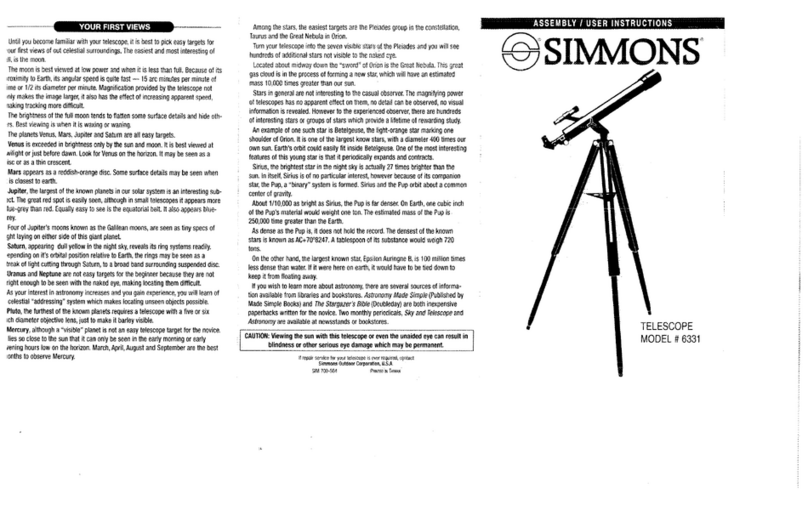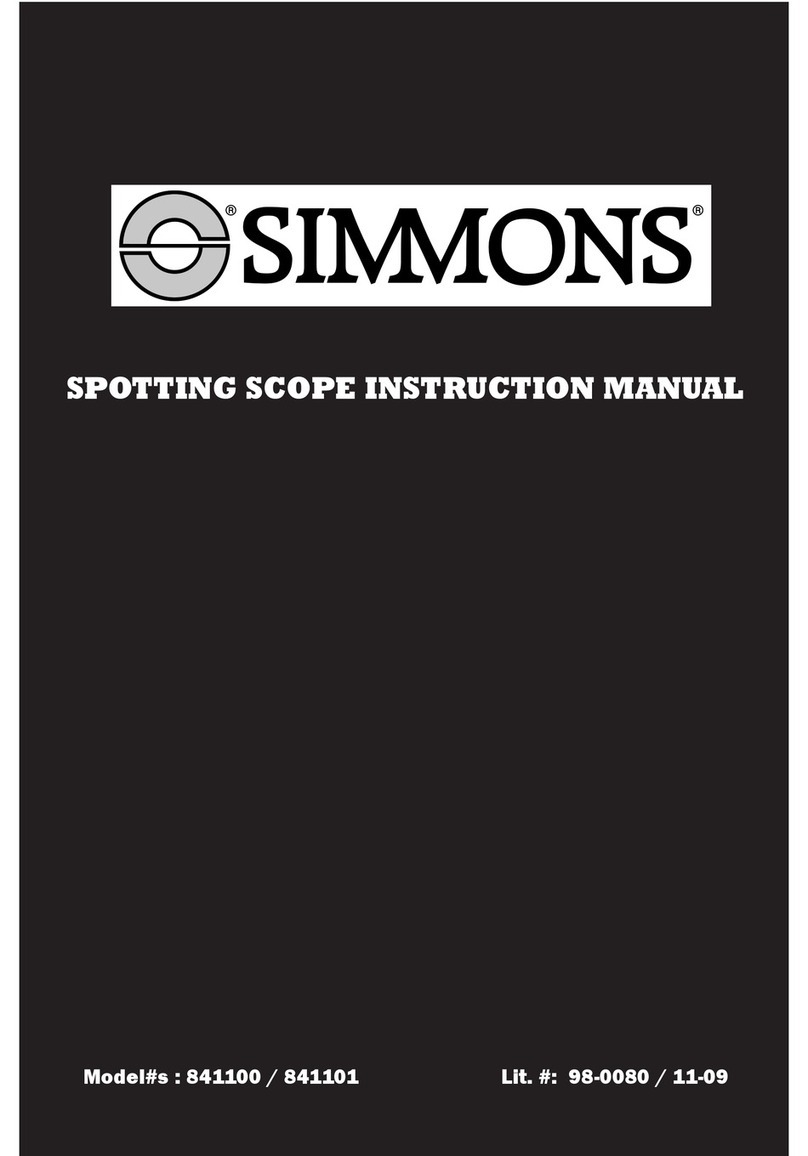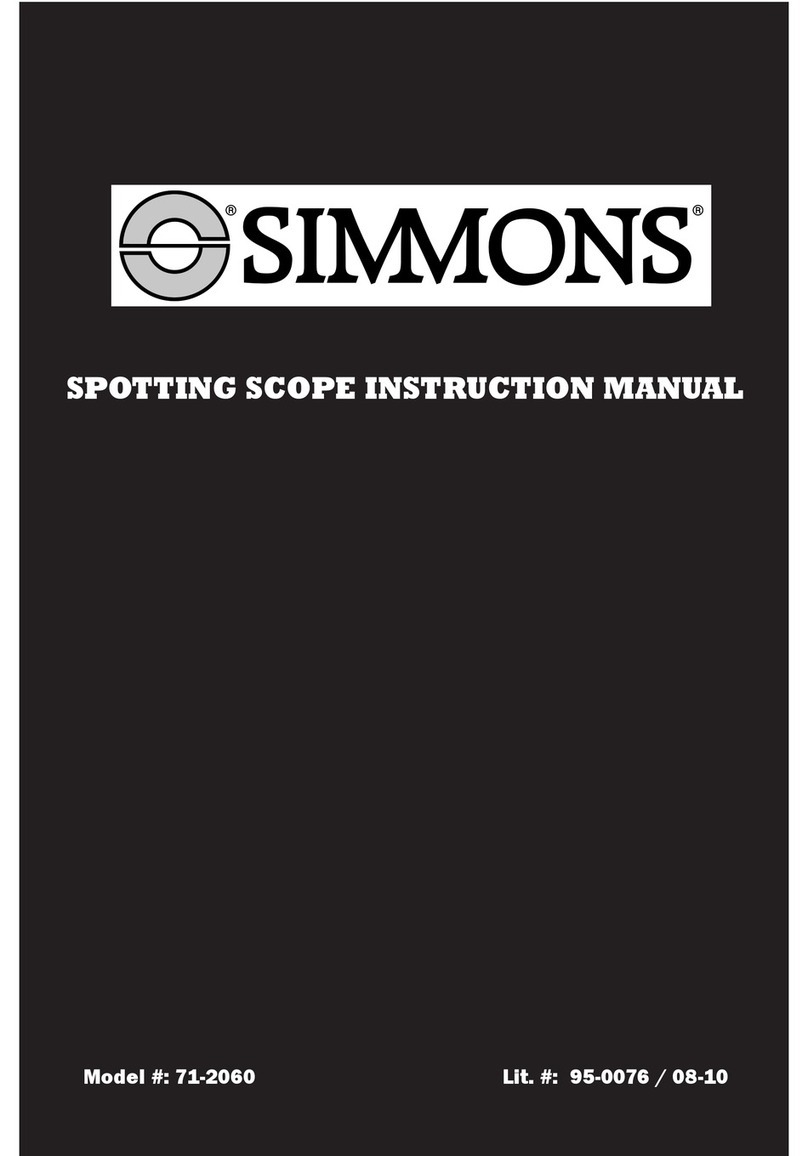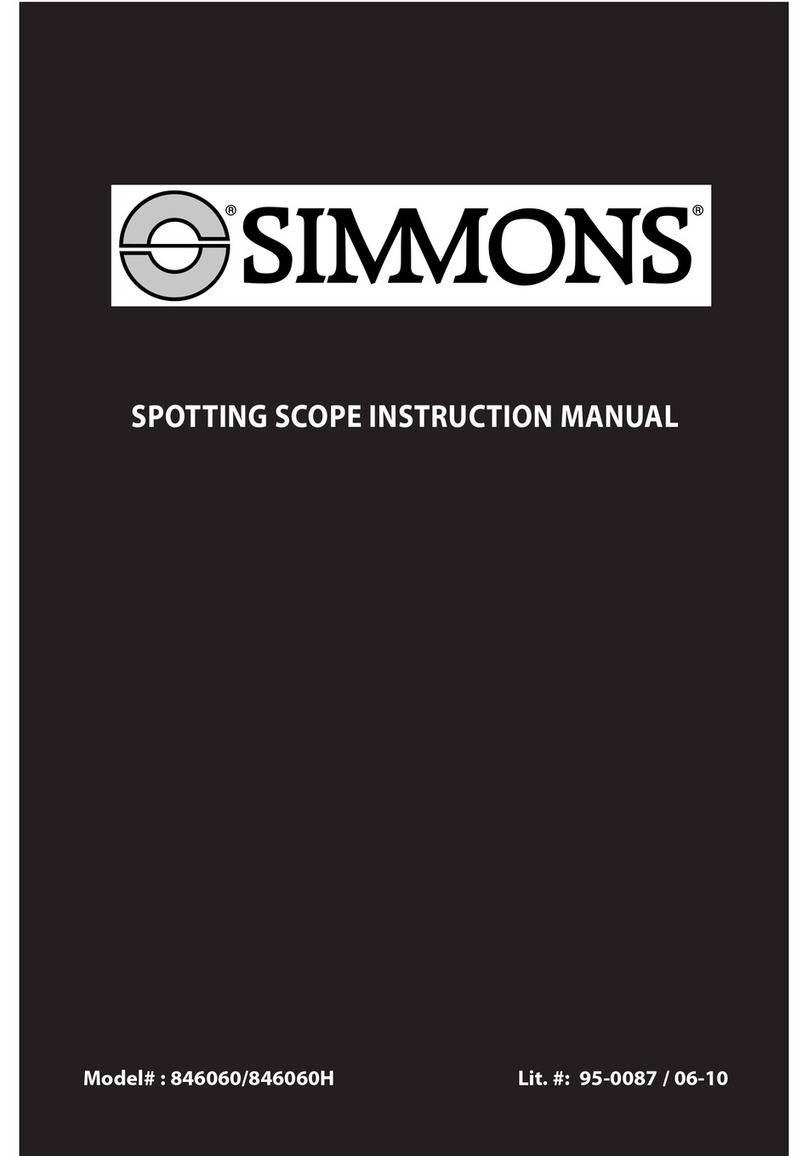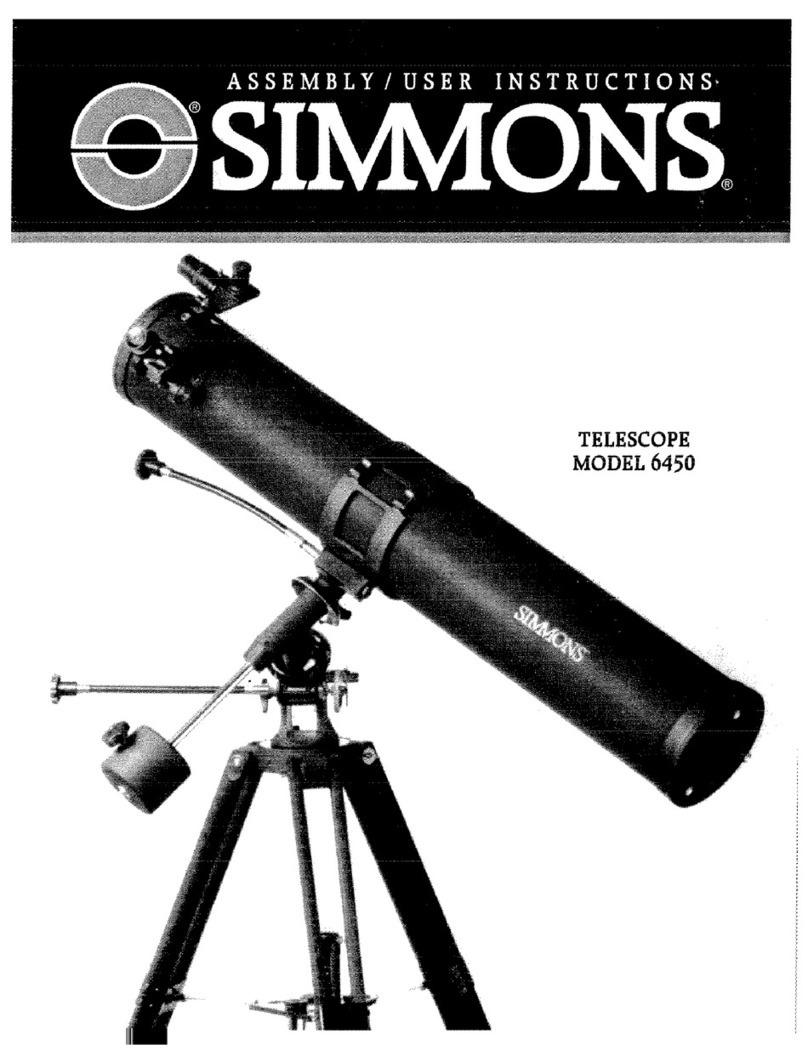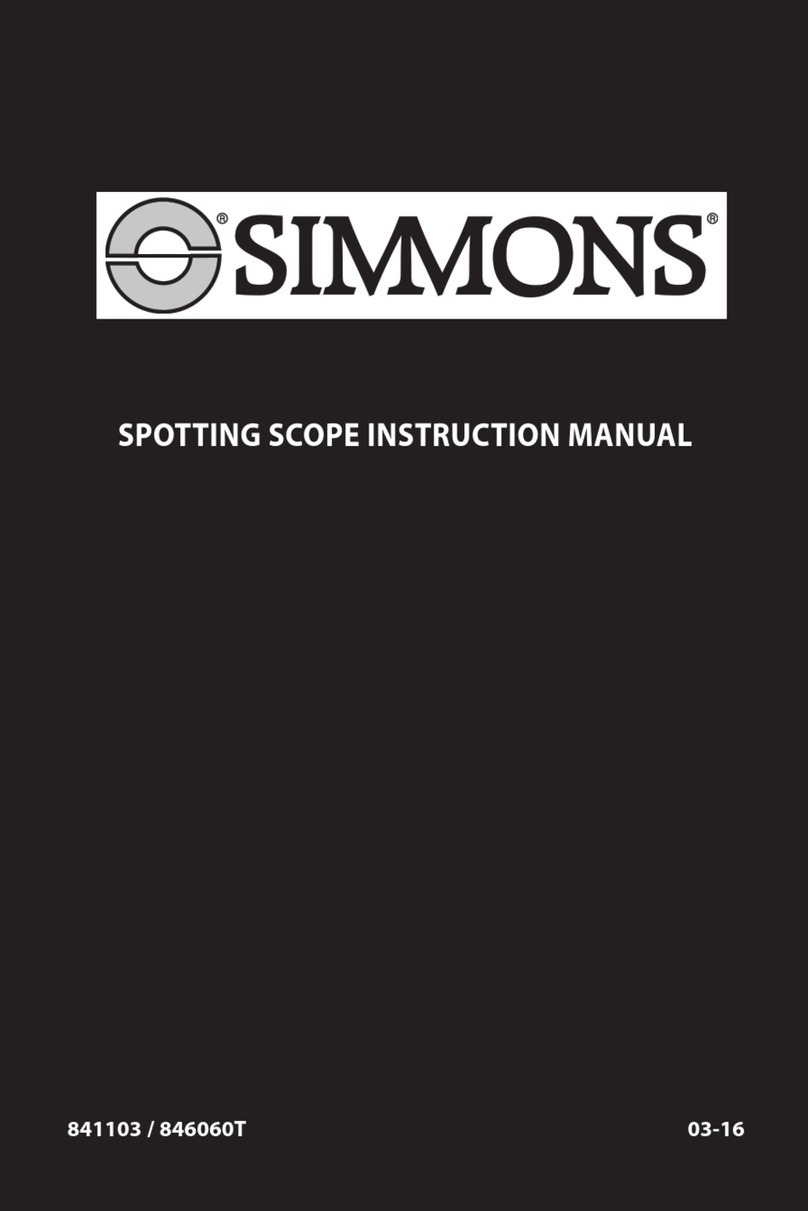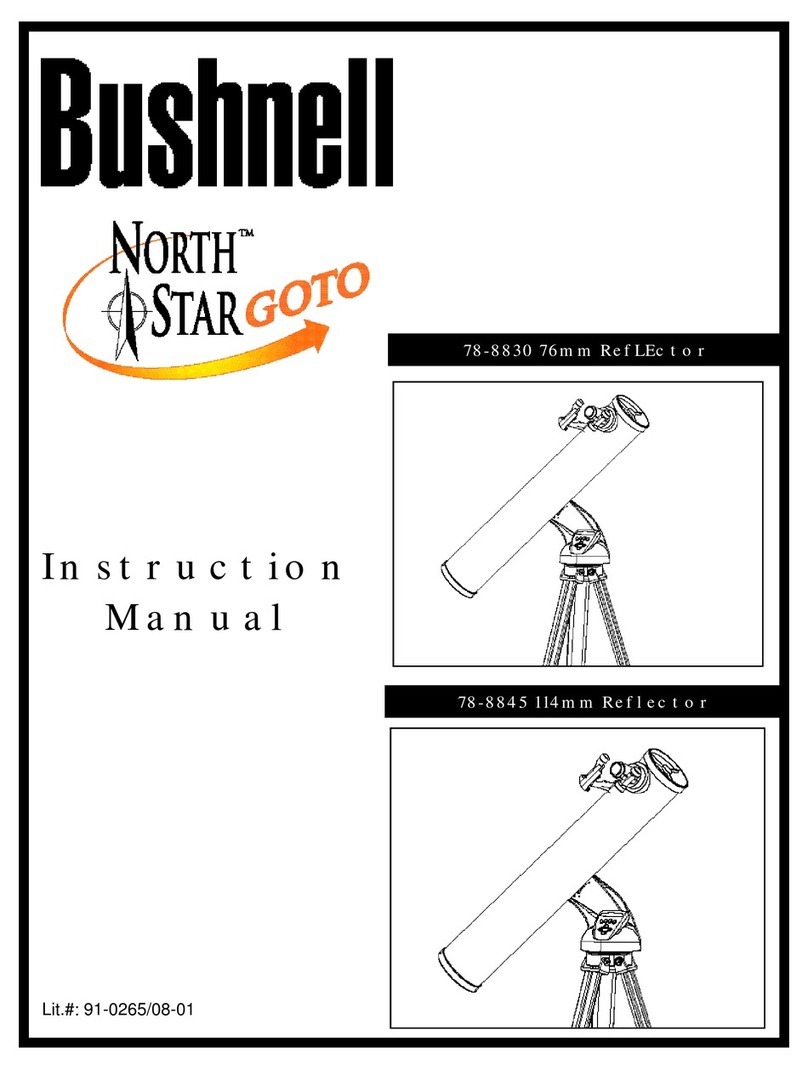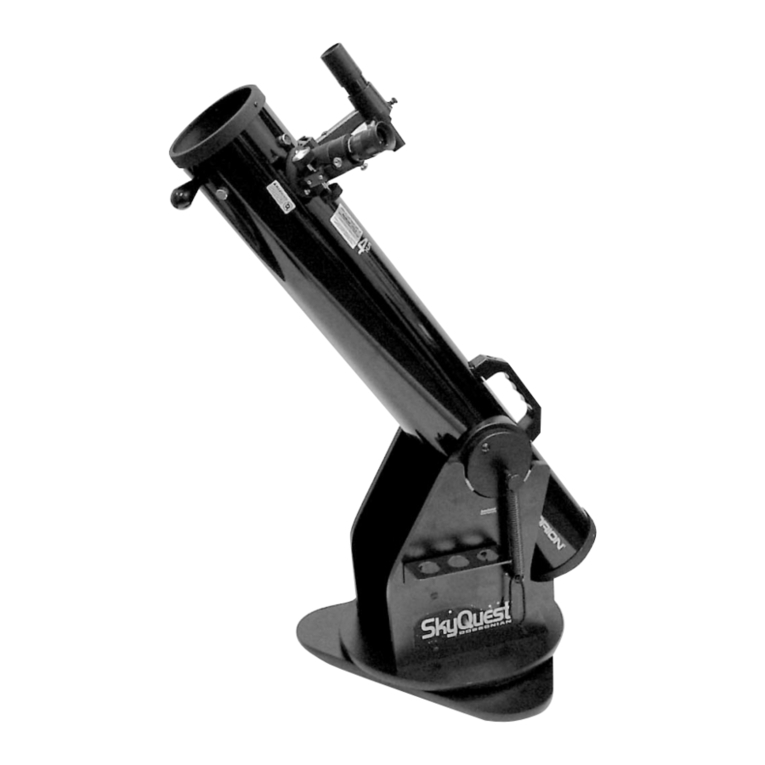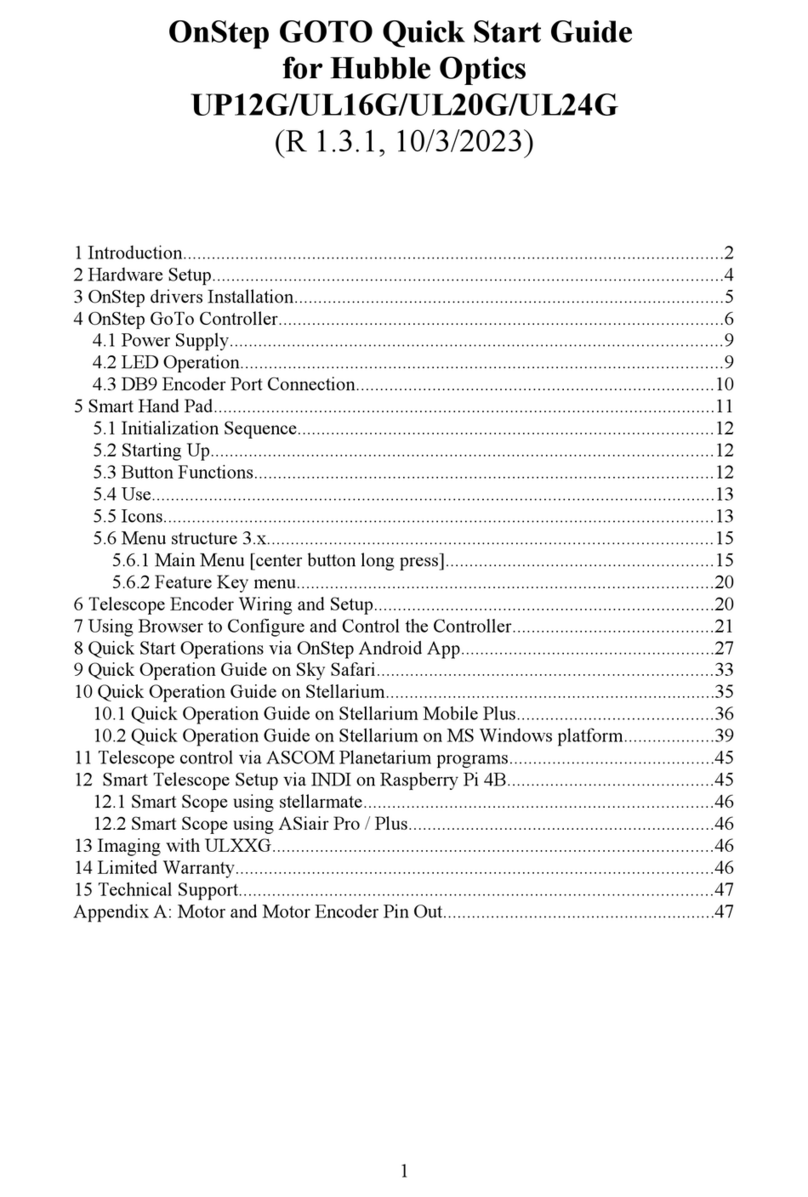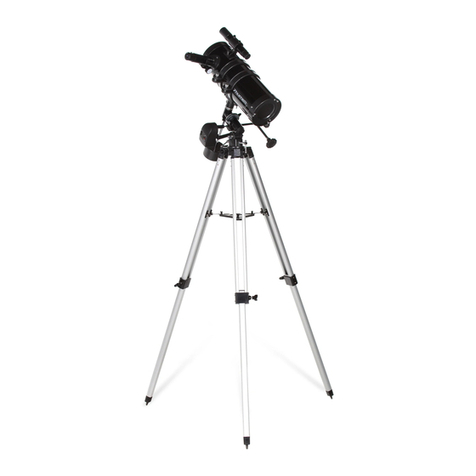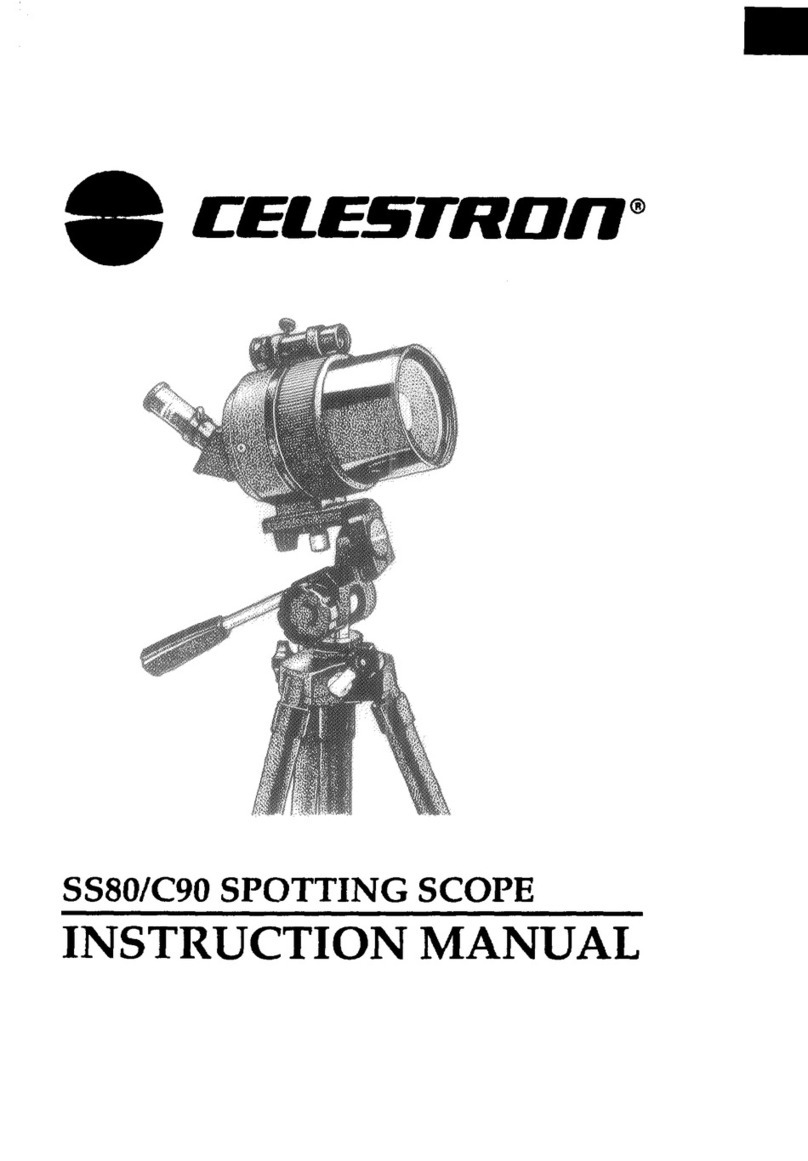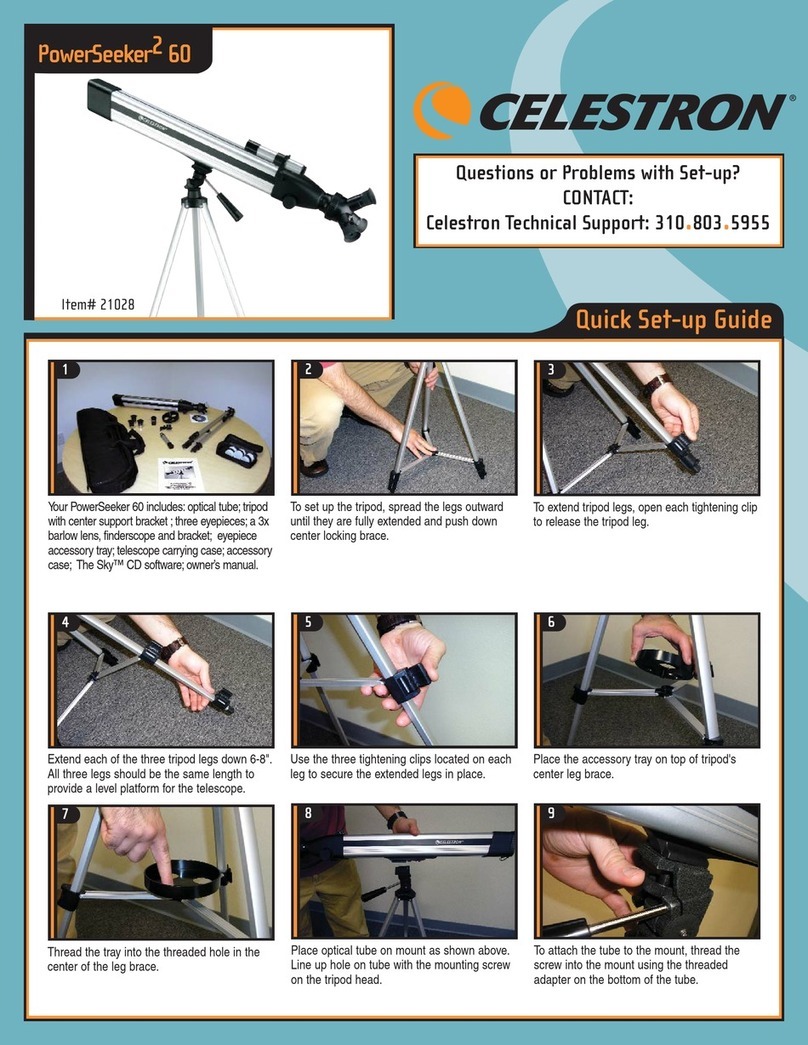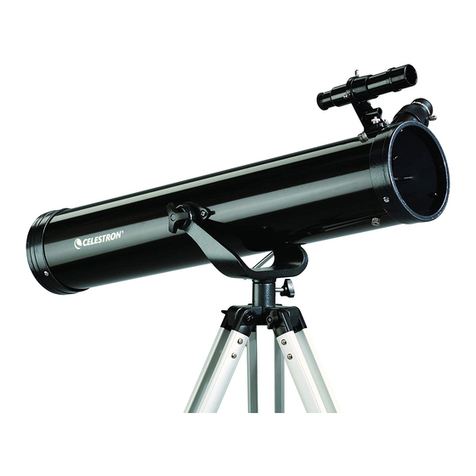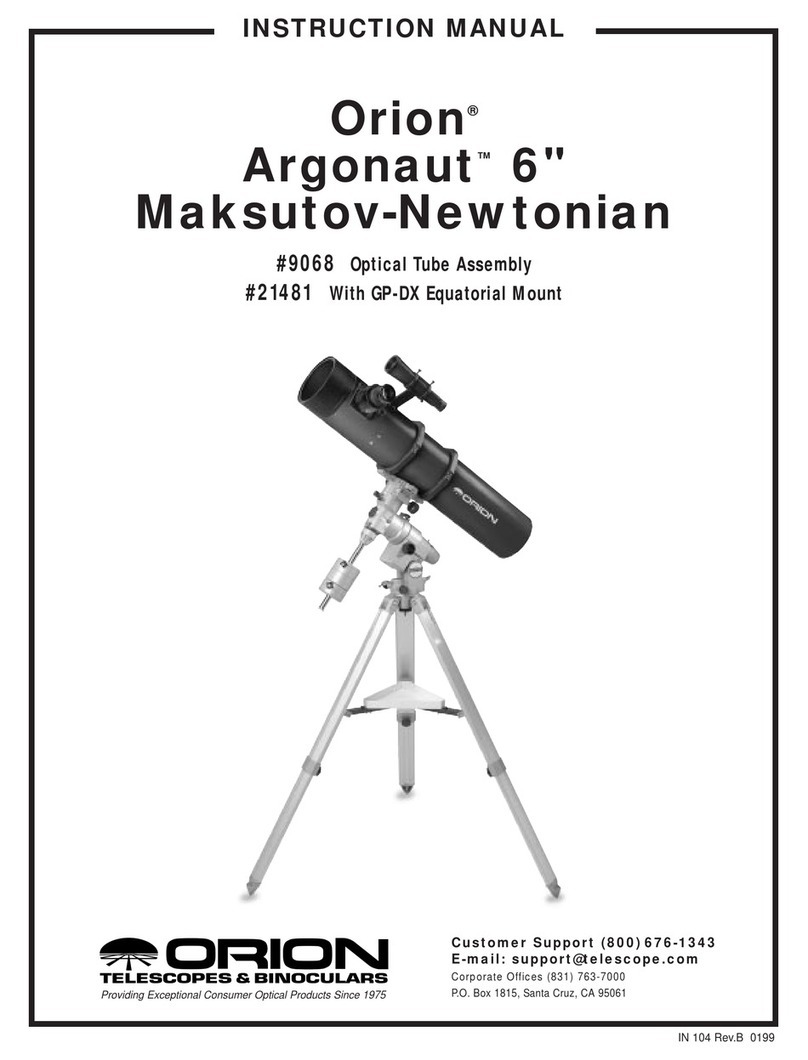Simmons 800447 User manual

Aiiiong
the
stars
the
easiest
targets
are
the
Pleiades
group
in
die
constellation.
Taurus
and
the
Great
Isebuia
m
Orion.
Turn
?our
idei^ope
onto
the
seven
visibie
stars
oi
the
Plf-iades
and
you
will
huisdreds
oi
additional
stats
not
visible
to
the
naked
eye.
!.i.xatai
about
midway
down
the
'sword"
oi
Onon
is
the
Great
Nebula.
This
great
gas
doud
Ls
m
the
process
of
form¬
ing
a
new
star,
whicli
will
liave
an
estimated
mass
20,0CX3
times
greater
than
our
suii.
Stars
in
general
are
not
intetesiii^
to
the
casual
oliserver.
The
magnifying
[X)wer
oi
telescopes
lias
no
apparent
effect
on
them,
no
detail
can
be
observed,
no
casual
infonnaticn
is
rtmealed.
However
to
the
expenenced
observer,
there
are
hundreds
of
inieiesting
stars
or
groups
of
stars
which
pro¬
vide
a
lifetime
of
rewarding
study.
An
example
of
one
such
star
Is
Beielgeuse,
the
light-orange
star
marking
one
shoulder
of
Orion,
it
Is
one
of
the
largest
known
stars,
with
a
diameter
4X)
times
our
own
sun.
Earth’s
orbit
could
easily
fit
inside
Betelgeuse.
One
of
the
most
interesting
features
of
this
young
star
is
that
it
periodi¬
cally
expands
and
contracts.
Sinus,
the
brightest
sar
in
the
c^t
sky
is
asualh'
27
omes
brighter
tl-ian
the
sun.
in
it^
Sirkis
is
erf
no
parttular
interest,
however
because
of
its
ccHupantoi
sor.
die
a
'binary"
systan
tewnsd.
Sirius
and
the
orbit
abait
a
common
center
of
pavtty.
Atout
1/lO.OnO
as
bright
as
Srius,
The
ftip
is
far
deiser.
On
Earth,
one
cubic
inch
of
the
P^i’s
mat«iai
would
we^
one
ton.
The
estunated
mais
of
tte
fHip
is
250.000
nme
greater
than
the
Earth.
As
derese
a.s
the
Pup
is.
it
does
brfd
the
reowd.
The
densest
of
the
known
stars
e>
known
as
AC+70°
8247.
A
tablespoon
of
its
substaice
wcwld
weigh
720
ttsE.
On
the
other
haral
the
largest
known
star,
Ejsilon
Auringne
B.
is
100
million
limes
k.'ss
dense
than
water.
If
it
were
here
on
earth,
it
wchM
have
to
be
ded
down
to
keep
it
ftom
floating
away.
If
you
wish
to
kam
more
about
astronomy,
there
are
sever¬
al
sources
of
Information
availaUc
from
libraries
and
book¬
stores.
CAin'IOli:
Viewing
the
sun
with
this
telescope
or
even
the
unaided
eye
can
result
in
blirfdiress
ororiieriieTtoas'eye
darnage'wlrichTna7'be'perOTanient.
:
'
—
Sinimom
fimiieci
Qfetime
Warranty’'
—
Sivimoris
xiHimnts
this
product
to
be
fnx
m
mterials
and
uvrbnanship.
Simmons
will
rejxiir
or
at
Us
option,
n'pkir
this
proiliict
without
(mrge
with
rrspirt
to
}vrts
and
lalm,
pmviding
our
eximiinatm
indiaites
that
a
ihfxi
exists.
In
the
evetif
this
product
model
is
no
Imgernmlame
at
the
time
mrruntu
senm-c
is
requindand
Simmons
Im
electai
repiacement,
a
siihstitution
irf
ecpial
or}(tvater
value
and
sinri-
lar
fTfrf'onmnce
will
he
made.
This
mrranty
does
not
include
damage
caused
bp
abuse,
miproper
Imndling,
installaim,
maintenance,
unauthorized
rqxiirs
or
modifications.
No
implied
warrantp
of
this
product
is
extended.
Some,
static
do
not
allow
limitathns
of
imfrfittf
uvnnmiy,
.so
tin's
limitation
nm
not
apply
to
you.
In
that
mmt
any
such
implied
mrranty
is
Imtd
to
that
required
by
law.
Simmorrs
shall
not
be
liable
tor
inddmtal
or
consequential
damages,
inciuding
but
not
limited
to
lost
prohls
or
other
n-oriomic
nr
(vnimcrcial
losses.
For
warranty
or
non-wamnly
re}iairs,
product
should
be
returned
postage
prepakl
to
Simmons
Outdiwr
Corfwratm.
When
returning
product
for
savice
(warranty
and
non-warranty)
include
a
note
l^.xphunmg
tlw
problem.
Return
product
with
a
check
or
money
order
in
the
amount
of
$7.()0
to
cover
Imndling
and
fx>stage.
for
mm
uarranly
nfuirs
you
will
be
iidvis<d
(f
the
senhee
charges
prior
to
any
wvrk
being
done,
'his
uarranly
gkvs
you
certain
legal
rights
arul
you
may
hazv
other
rights
which
vary
twin
state
to
slate.
defined
by
federal
law,
this
is
li
limited
warranty.
■
Mtts
w/iiT.itily
imly
.ippiifs
in
llw
CGntiiii-nCil
Uniti-d
Stales.
SIM
1000
Simmons
Outdoor
Corporation.
201
Plantation
Oak
Drive,
Thomasvilie.
Georgia
31792
6/22'99
Printed
in
Chma
Imprime
a
China
Impreso
en
China
Gcdruckl
in
China
Stampato
in
China
525
POWER
/
60MM
REFRACTOR
TELESCOPE
ASSEMBLY
AND
USER
INSTRUCTIONS
For
Models:
800447
800449
800450
800723

H^TEs
Objecis
will
^^)ear
reversed
(minDi
im^e).
3.
Refine
aiming
of
tefecc^
as
needed
to
teato
target
object
in
die
field
of
view.
Ti^ten
azimuth
locking
screw
to
prevent
fvsrths
nxjvement.
4.
Look
into
tte
findeisccpe
(ob^ts
tviH
tip-skic
tkswni-
Fogis
by
rotating
fiiKlet
eyqjkie.
Ctmter
tar¬
get
object
on
crcsshair
intersecttcm
by
mming
the
alignnynr
screws
in
the
finderso^
bracket.
5.
Replace
the
H2hniney^ptece
with
the
H!2.'3mm
eyqjietK.
^p^t
stqis
3
and
4
Remove
dia^nal
mir¬
ror
and
eyqtKce
Rtplace
diagonal
mirror
with
the
Barbw
Ims.
Insert
{120niQi
eyt^nece
into
Barfow
lens
and
rqieat
the
al^nment
process.
DSIN6
m
T-18
The
Tl&iun
ey^iecc
produa-*s
normal
images
for
terrestrial
viewing.
To
use,
remove
the
diagonal
minor
fiom
focusing
tube
and
replace
with
the
T18
eyepiece.
The
'f
18
also
works
as
a
14X
mlaoscope.
Place
dear
plasUc
end
over
object
to
be
inspected.
GETTING
m
HOST
GOT
OF
YOOB
mESCOPE
Take
the
time
to
become
familiar
with
your
new
telescope.
Learn
the
names
of
the
vaticHis
parts,
where
they
are
locat¬
ed
and
how
they
work.
It
is
best
to
do
this
in
the
day
time.
Notice
how
as
magnilicaUon
is
Increased,
the
image
becomes
darker,
the
field
of
view
(area
seen
throu^
the
telesccqje)
decreases
and
focusing
becomes
more
alQcal.
When
setting
up
for
a
viewing
session,
place
the
telescope
in
an
area
shdtered
from
the
wind
if
possible.
Best
night
lime
viewing
will
be
away
from
city
l^ts
and
when
the
atmosphere
is
"steady"
(good
viewing
oanditions).
With
a
Ittile
praaice,
you
will
learn
to
judge
when
viewnng
condi¬
tions
are
good.
Look
for
the
ni^ts
where
the
stars
shine
lastly
with
little
or
no
twinkling.
Use
bw
power
to
take
advantage
of
the
wider
field
of
view
aiKl
brighter
images.
Reserve
your
hi^
powers
for
those
nights
when
viewing
conditions
are
really
good
and
there
is
SKiK
detail
to
be
seen.
If
thee
is
an
astroiKimy
dub
in
your
area,
consider
becom¬
ing
a
member.
Yew
can
learn
more
in
an
hour
from
experi¬
enced
hoHiyists
than
in
a
month
of
uninfonned
casual
olKerving.
The
chamber
of
commerce,
library,
science
museum
or
planetarium
may
have
information
regarding
neaiby
dubs.
Until
you
become
familiar
with
yewr
telescxjpe.
it
is
best
to
pick
easy-
targets
for
your
first
views
of
our
ceiestlai
sur-
ioanding.
The
easiest
ami
most
interesting
of
alL
is
the
moon.
The
moon
is
Ixrst
viewed
at
bw
power
and
when
It
is
Less
tlian
full.
Because
of
its
pro.Kimity
to
Earth,
its
angular
speed
is
quite
fast
■
15
arc
niinutej;
per
sranure
of
time
or
1/2
its
diameter
pei
mrnuce.
Magnification
provided
by
the
tek^ope
not
only
makes
the
image
larger,
it
also
has
the
effect
of
increasing
apparent
speed,
making
tracking
mote
difficult.
The
bnghtness
of
the
full
moon
tends
to
flacien
some
sur¬
face
details
and
hide
others.
Best
viewing
is
when
it
is
waxing
or
waning.
The
planets
Venus,
Mats.
Jupiter
and
Saturn
are
all
easy
tar¬
gets.
Venus
us
exceeded
in
bngtitness
only
by
the
sun
and
moon.
It
is
best
viewed
at
cw'ili^t
or
just
before
dawn.
Look
for
Venus
on
the
horizon.
It
may
be
seen
as
a
disc
or
as
a
chui
crescent.
Mars
appears
as
a
reddish-orange
disc.
Some
surface
deiai.ts
may
be
seen
when
it
Is
it’s
ebsest
to
earth.
Jupiter,
the
largest
of
the
known
planets
in
our
solar
system
is
an
interesting
subject.
The
great
red
spot
Is
easily
seen,
although
In
sni^
telescopes
it
appears
more
blue-gray
dian
red.
Equally
easy
to
see
is
the
equatorial
belt.
It
al^
appears
bluc'-gray.
Four
of
Jupiter's
moons,
known
as
the
Galilean
inoons,
are
seen
as
Uny
specs
of
l^t
lying
on
either
side
of
this
giant
planet.
Saturn,
appearing
dull
yelbw
in
the
night
sky.
reveals
its
ring
systems
readily.
D^ndfng
on
ifs
orbital
positton
rela¬
tive
to
Earth,
the
rings
may
be
seen
as
a
streak
of
light
cut¬
ting
through
Saturn,
to
a
broad
band
surrounding
a
sus¬
pended
disc.
Uranus
and
Neptune
are
not
easy
targets
for
the
beginner
because
they
are
not
bright
enough
to
be
seen
with
tlie
ixaked
eye,
making
bating
them
difficult.
As
your
Interest
in
astronomy
increases
and
you
gain
expe¬
rience
you
will
learn
of
a
celestiai
"addressii^
system
which
makes
locating
unseen
objects
possible.
Pluto,
the
funheist
of
the
know'ii
planets
requires
a
tele¬
scope
with
a
five
or
six-inch
diameter
objective
lens,
just
to
make
it
barely
visible.
Mercury,
although
a
"visible"
planet
is
not
an
easy
telescope
target
for
the
novice,
it
lays
so
dose
to
the
sun
that
it
can
only
be
seen
in
the
early
morning
or
early
evening
hours,
low
on
the
horizon.
March,
April.
August
and
Si^ember
are
the
best
months
to
observe
Mercury.
This manual suits for next models
3
Other Simmons Telescope manuals
Popular Telescope manuals by other brands
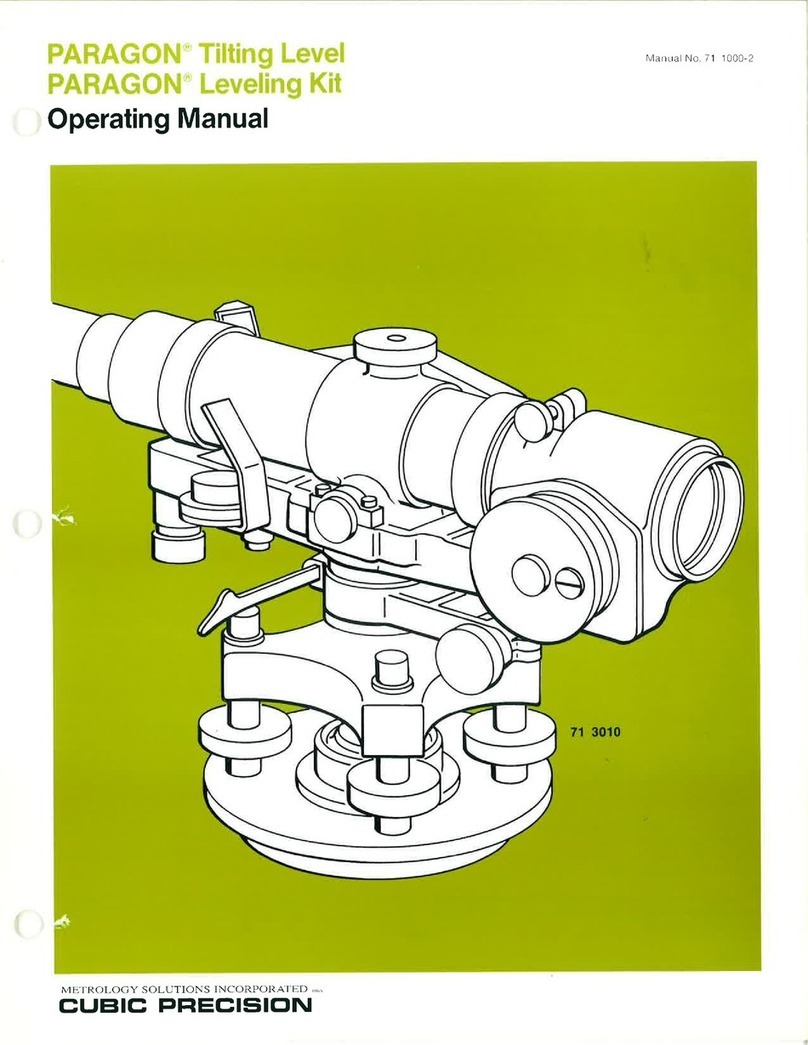
Paragon
Paragon Paragon Tilting Level manual

Bresser
Bresser National Geographic 114/500 operating instructions
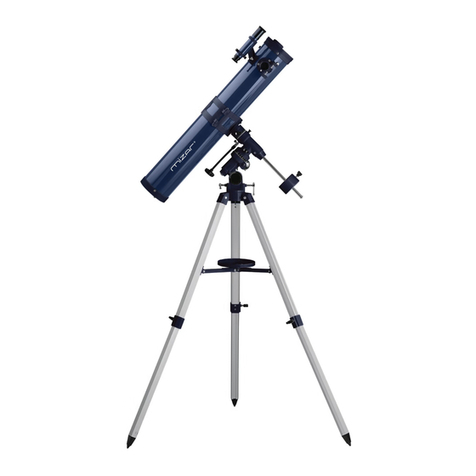
Mizar
Mizar MIZAR 114/900 user guide
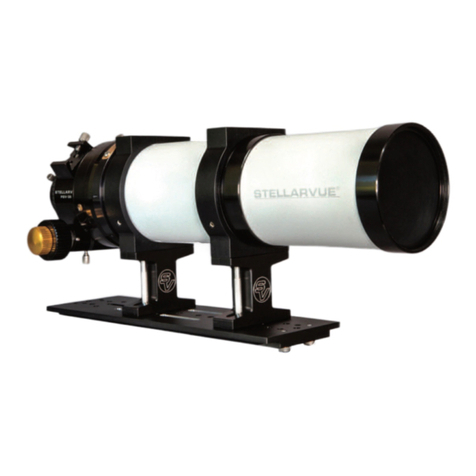
Stellarvue
Stellarvue PREMIER SVX80T-3SV Operator's manual

ORION TELESCOPES & BINOCULARS
ORION TELESCOPES & BINOCULARS 9978 instruction manual
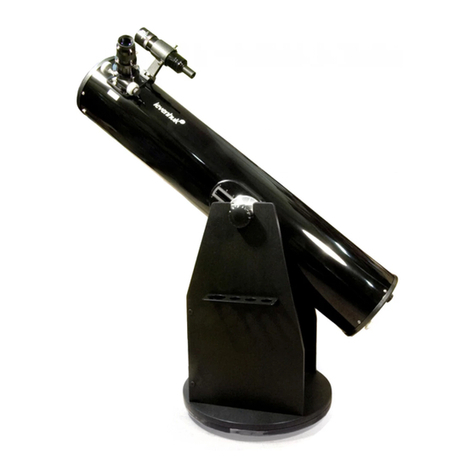
Levenhuk
Levenhuk Ra 200N Dob user manual
